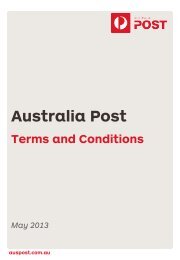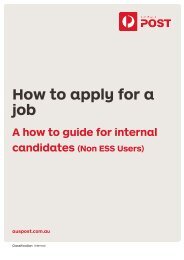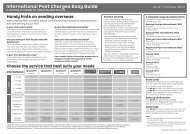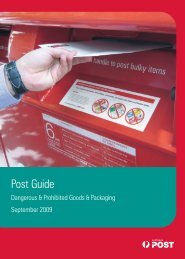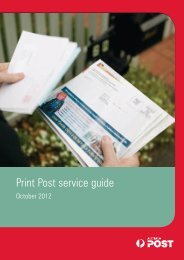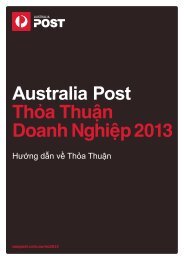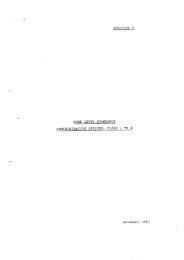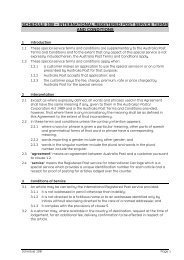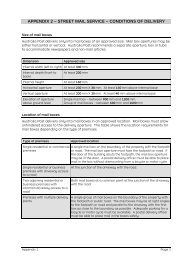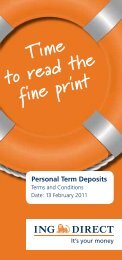2004-05 Annual Report - Australia Post
2004-05 Annual Report - Australia Post
2004-05 Annual Report - Australia Post
Create successful ePaper yourself
Turn your PDF publications into a flip-book with our unique Google optimized e-Paper software.
<strong>Australia</strong> <strong>Post</strong> <strong>Annual</strong> <strong>Report</strong> <strong>2004</strong>/<strong>05</strong> Financial and Statutory <strong>Report</strong>s<br />
Notes to and forming part of the financial statements<br />
| 102 |<br />
NOTES TO AND FORMING PART OF THE FINANCIAL STATEMENTS<br />
FOR THE YEAR ENDED 30 JUNE 20<strong>05</strong><br />
38. ADOPTION OF AUSTRALIAN<br />
EQUIVALENTS TO INTERNATIONAL<br />
FINANCIAL REPORTING STANDARDS (CONT.)<br />
Notes<br />
The notes below provide descriptions of the<br />
adjustments included in the net equity reconciliation<br />
of the corporation as at 1 July <strong>2004</strong> shown above.<br />
In addition, these notes describe the currently known<br />
impacts on the 20<strong>05</strong> balance sheet and profit and<br />
loss as a result of the implementation of A-IFRS.<br />
Management is in the process of completing the<br />
corporation’s A-IFRS balance sheet as at 30 June 20<strong>05</strong><br />
and the A-IFRS income statement for the year ended<br />
30 June 20<strong>05</strong>.<br />
(i) The corporation has elected to adopt early the<br />
revised standard, AASB 119 Employee Benefits<br />
(December <strong>2004</strong> version). Under this standard<br />
the corporation will recognise the net surplus<br />
in its employer-sponsored defined benefit fund<br />
as an asset. This differs to the existing policy<br />
where amounts relating to the fund remain off<br />
balance sheet. The recognised asset will be<br />
subject to future changes in value resulting from<br />
movements in the fair value of the assets of the<br />
fund and changes in the underlying defined benefit<br />
obligation. Independent actuaries have been<br />
engaged to assist in calculating the impacts of<br />
AASB 119 on the corporation.<br />
The implementation of A-IFRS also impacts the<br />
superannuation expense. Under current accounting<br />
policies, superannuation expense is recorded<br />
when cash contributions are made to the fund.<br />
The accounting policy the corporation has adopted<br />
under AASB 119 requires the inclusion of the<br />
current service cost, interest cost, expected return<br />
on plan assets and past service cost as part of the<br />
superannuation expense. Under AASB 119, the<br />
corporation will recognise actuarial gains and losses<br />
directly in the statement of changes in shareholder’s<br />
equity. The implementation of AASB 119 is expected<br />
to reduce the 20<strong>05</strong> earnings of the corporation<br />
compared to the existing accounting policy.<br />
(ii) Under AASB 116, Property, Plant and Equipment,<br />
the corporation is required to perform valuations on<br />
an asset-by-asset basis rather than the current basis<br />
where certain valuations are performed on a class<br />
basis. If AASB 116 had been applied historically,<br />
certain assets would have been reduced in value<br />
when valued on an individual asset basis.<br />
(iii) Under AASB 116, Property, Plant and Equipment, the<br />
corporation is required to account for revaluations<br />
of assets on an asset-by-asset basis rather than the<br />
current basis where valuation re-assessments are<br />
accounted for on a class basis. If AASB 116 had<br />
historically been applied to the corporation, certain<br />
devaluations that had been applied to the asset<br />
revaluation reserve would have been required to be<br />
taken directly to the income statement. The effect<br />
of this is a reduction in retained earnings and an<br />
increase in the asset revaluation reserve on adoption<br />
of AASB 116.<br />
(iv) Under AASB 120 Government Grants, grant income<br />
is matched according to the pattern of benefit<br />
or obligation. Accordingly, any unearned income<br />
will be deferred rather than be recognised where<br />
the corporation has control of the grant, as is the<br />
case under the existing accounting policy. This<br />
results in a decrease in net equity upon adoption<br />
of AASB 120. The introduction of AASB 120<br />
will increase 20<strong>05</strong> earnings.<br />
(v) Under AASB 112 Income Taxes, the corporation<br />
would be required to use a balance sheet liability<br />
method, rather then the current income statement<br />
method which recognises deferred tax balances<br />
where there is a difference between the carrying<br />
value of an asset or liability and its tax base. The<br />
primary impact of this approach is the recognition<br />
of a deferred tax liability in relation to the revalued<br />
assets. Under the existing accounting policy the tax<br />
effect of asset revaluations was not recognised.<br />
Further, as a result of recognising deferred tax<br />
liabilities in relation to the revaluation of land,<br />
unused tax capital losses will be recognised on the<br />
balance sheet as an asset.<br />
The above changes will result in an increase in the<br />
net deferred tax liability under A-IFRS at transition<br />
balance sheet as follows:<br />
Retained earnings<br />
impact of items (i)<br />
to (v) above<br />
Reserves impact of<br />
item (v) above<br />
Increase in deferred<br />
tax liability<br />
Consolidated<br />
$m<br />
Corporation<br />
$m<br />
218.2 218.2<br />
52.3 52.3<br />
270.5 270.5<br />
No other material adjustments to deferred taxes would<br />
be expected on adoption of AASB 112 Income Taxes.




